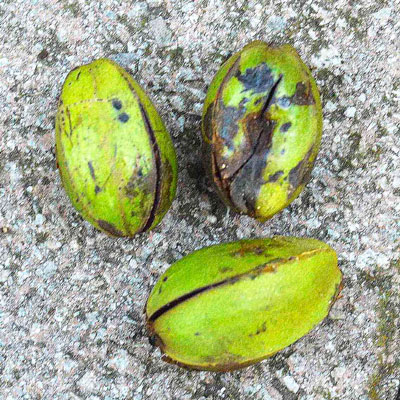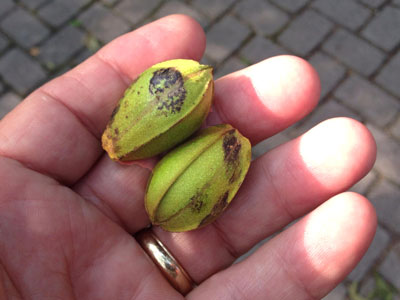Question of the Week #1: August 11, 2016
“Neil, why are so many of my pecans falling now? They have dark splotches on their husks. Are they any good?”
I have this same issue with my own pecans, and I’ll explain what I do in a moment.

Pecan scab causes fruit to fall several months early. For those that are infected, this is how the husks look about now.
Pecan scab is a fungal disease that actually attacks pecans soon after the nuts begin to form in late spring. It is much worse in areas with high humidity, so the farther east you go in the state, the more likely you are to lose pecans to pecan scab. That’s why it’s important that you plant resistant varieties, and Caddo is one that is most highly recommended.
As you’re shopping online and in nurseries, you’ll see pecans grouped into “eastern” and “western” varieties, and Interstate 35 is commonly used as the rough dividing line. Pecan scab is one of the main reasons for that differentiation.
Native pecans will have varying degrees of resistance to scab, but it’s safe to say that most will be impacted if you’re in the eastern half of the state.

These native pecans have just fallen because of pecan scab. The black splotches will soon engulf entire husk and the kernels inside. There is no “control” at this point.
There are fungicides that are specifically labeled for use with pecan scab. However, this disease is more easily “prevented” than “cured.” Even though you don’t see scab on the husks until late in the summer, you’ll want to include a suitable fungicide with each insecticidal spray you make beginning with the pecan nut casebearer spray in mid- or late May. Combine the fungicide with the insecticide as you mix up the spray.
Your other option, and the one that I follow, is to accept my losses to scab and insects. It’s cumbersome for a home gardener to hook up a spray rig that can reach completely to the top of a large pecan. Sure, I lose a percentage of my crop each year, but I can’t justify the time and expense of trying to treat for them on a one- or few-tree basis. I still get plenty of good pecans when they start falling at their normal November time.
As for whether the pecans that fall now are still usable, one quick slice through one of them will give you the answer. No, not at all.
